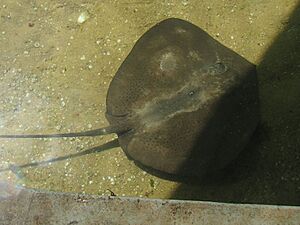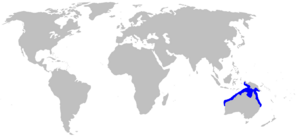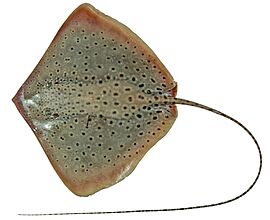Black-spotted whipray facts for kids
Quick facts for kids Black-spotted whipray |
|
|---|---|
 |
|
| Conservation status | |
| Scientific classification | |
| Genus: |
Maculabatis
|
| Species: |
astra
|
 |
|
| Range of the black-spotted whipray | |
| Synonyms | |
|
|
The black-spotted whipray (Maculabatis astra) is a type of stingray. You can find it in the ocean waters near southern New Guinea and northern Australia. For a long time, people thought it was just a different kind of brown whipray.
This stingray has a cool, diamond-shaped body. Its tail is long and thin, like a whip, and doesn't have any folds. It's easy to spot because of its unique pattern. Its back is grayish-brown with many small, dark spots. Sometimes it even has white spots too! The tail has stripes that go light, then dark, then light again. This ray can grow up to 80 cm (about 31 inches) wide.
Black-spotted whiprays mostly eat Crustaceans, like crabs and shrimp. Female whiprays give birth to live young, usually 1 to 3 babies at a time. They feed their babies a special "uterine milk" inside them. Most of these stingrays live in Australian waters. Here, they are not in much danger from fishing. This is because special tools are used to help prevent them from being caught by accident. Some are caught by fishers in Indonesia and Papua New Guinea. But overall, their numbers are healthy. The International Union for Conservation of Nature (IUCN) lists them as "Least Concern."
| Top - 0-9 A B C D E F G H I J K L M N O P Q R S T U V W X Y Z |
What is the Black-Spotted Whipray?
The black-spotted whipray was once thought to be the same as the brown whipray. Scientists from the Commonwealth Scientific and Industrial Research Organisation (CSIRO) first noticed a spotted version in 1994. They called it "Himantura sp. A" back then.
Later, in the mid-2000s, more stingray samples became available. This helped scientists confirm that the black-spotted whipray was its own unique species. In 2008, Peter Last, Mabel Manjaji-Matsumoto, and John Pogonoski officially described it. They gave it the name astra, which comes from the Latin word for "constellation" (a group of stars). This name fits because of its spotted pattern!
Some other common names for this ray are coachwhip ray and wulura.
How to Identify a Black-Spotted Whipray
The black-spotted whipray can grow to about 80 cm (31 inches) wide. Its body, called a disc, is shaped like a diamond. It's quite thin and a bit wider than it is long. The corners of its body are somewhat sharp. Its snout is triangular and has a slightly pointed tip.
Its eyes are small, and right behind them are larger, oval holes called spiracles. These help the ray breathe. The mouth is shaped like a bow. Inside, it has small, blunt teeth.
Body and Tail Features
The ray's pelvic fins are small. Its tail is very thin and looks like a whip. It's usually 2 to 2.7 times longer than the body is wide. The tail has one or two thin stinging spines. Many rays might be missing their sting. Behind the sting, the tail has a deep groove and ridges.
The top of the ray's body is covered in tiny, heart-shaped bumps called dermal denticles. These are like tiny scales. Newborn rays don't have these bumps.
Color and Pattern
The black-spotted whipray is grayish-brown on top. It has many small, dark spots covering its body and the base of its tail. Sometimes, it also has white spots. These white spots might form rings around the dark spots. The tail, past the sting, has alternating light and dark stripes. Young rays have clearer stripes that go all the way around their tail. The top half of its eyeball is spotted, while the bottom half is white. The underside of its body and tail is plain white.
Where Do Black-Spotted Whiprays Live?
You can find the black-spotted whipray in many places off northern Australia. This includes Shark Bay in Western Australia and Moreton Bay in Queensland. They are especially common in the Gulf of Carpentaria. They have also been seen near southern New Guinea.
This ray is a bottom-dwelling species. This means it lives on the seafloor. It prefers coastal waters that are 1 to 141 meters (3 to 463 feet) deep. They like sandy areas. They tend to live farther from the shore than the brown whipray. In Shark Bay, more black-spotted whiprays are found during the warmer months.
What Do Black-Spotted Whiprays Eat and How Do They Live?
More than 90% of the black-spotted whipray's food is crustaceans. In the Gulf of Carpentaria, they are big predators of penaeid prawns. These prawns make up over half of their diet!
Young rays, under 23 cm (9 inches) wide, mainly eat shrimp. As they get older, they start eating more stomatopods (mantis shrimp) and crabs. For rays living off Queensland and in the Torres Strait, polychaete worms are also an important food source. Sometimes, these rays will even eat bony fishes.
Reproduction
Like other stingrays, the black-spotted whipray gives birth to live young. This is called aplacental viviparous. The mother feeds her babies a special, nutrient-rich liquid called "uterine milk" inside her body.
Female rays have one working ovary and uterus (on the left side). They usually give birth to 1 to 3 pups at a time. Newborn rays are about 17 to 19 cm (6.7 to 7.5 inches) wide. Both male and female rays become ready to have babies when they are about 46 to 50 cm (18 to 20 inches) wide. They grow slowly, and females grow even slower than males.
Are Black-Spotted Whiprays in Danger?
The International Union for Conservation of Nature (IUCN) assessed the brown whipray in 2004. At that time, the black-spotted whipray was included in that assessment. They were listed as "Least Concern". This means they are not currently in danger of disappearing.
Their home range off northern Australia is very large. It is also quite protected from too much fishing. This is because special devices, called Turtle Exclusion Devices (TEDs), are now required on fishing nets. These devices help reduce the number of rays and other animals caught by accident.
In Indonesian waters, a small number of black-spotted whiprays are caught. Their skin is very valuable, and their meat and cartilage are also used. Off Papua New Guinea, young rays are sometimes caught by accident in nets used to catch prawns.



